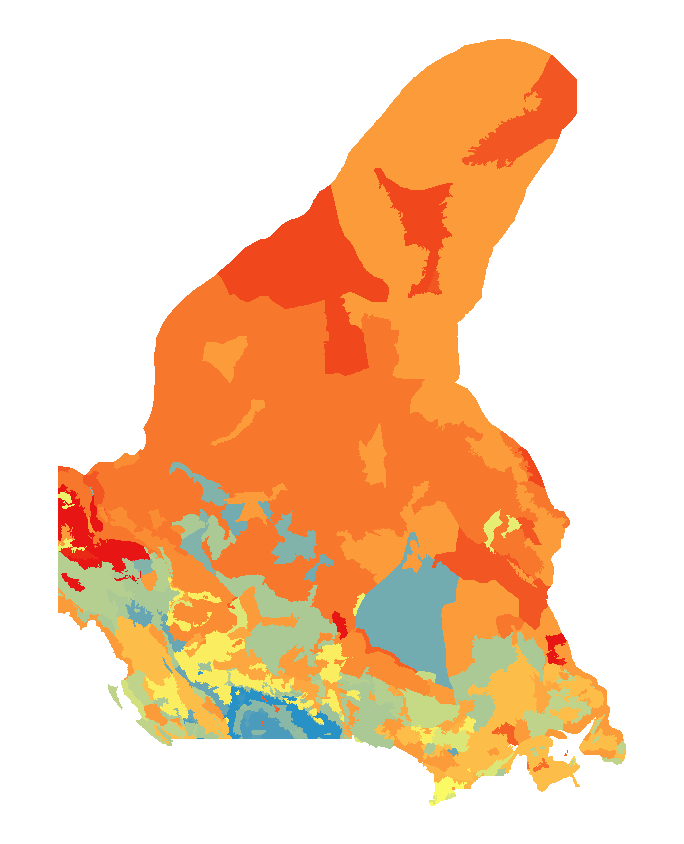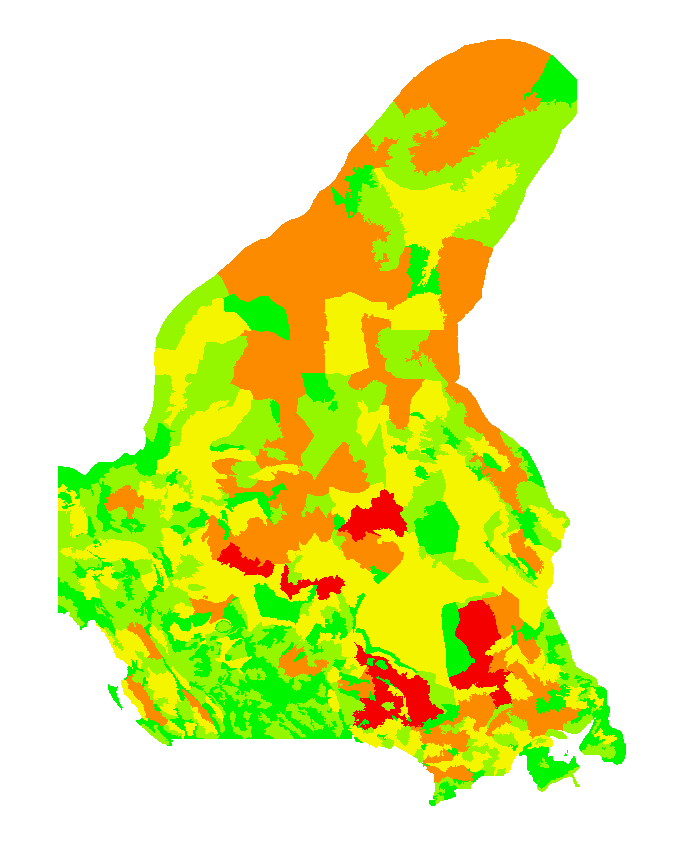Environnement
Type of resources
Available actions
Keywords
Contact for the resource
Provided by
Years
Formats
Representation types
Update frequencies
status
Service types
-

The National Ecological Framework for Canada's "Total Land and Water Area by Ecoprovince” dataset provides land and water area values for ecoprovince framework polygons, in hectares. It includes attributes for a polygon’s total area, land-only area and large water body area.
-

The “Terrestrial Ecoregions of Canada” dataset provides representations of ecoregions. An ecoregion is a subdivision of an ecoprovince and is characterized by distinctive regional ecological factors, including climate, physiography, vegetation, soil, water, and fauna. For example, the Maritime Barrens ecoregion (no. 114) is one of nine ecoregions within the Newfoundland ecoprovince.
-

The National Ecological Framework for Canada's "Soil Texture by Ecoprovince” dataset contains tables that provide soil texture information within the ecoprovince framework polygon. It provides soil texture codes and their English and French language descriptions as well as the percentage of the polygon that the component occupies. Soil texture indicates the relative proportions of the various soil separates (sand, silt, clay) as described by classes of texture. Soil separates are mineral particles, 2.0 mm in diameter and include: gravel 0.2 -7.5 cm and cobbles 7.5-25.0 cm. There are 12 texture group classes definitions and one class definition for Not Applicable (which indicates, for example, water, ice or urban areas).
-

The National Ecological Framework for Canada's "Permafrost by Ecoregion” dataset contains tables that provide permafrost information within the ecoregion framework polygon. It provides permafrost codes and their English and French language descriptions as well as information about the percentage of the polygon that the component occupies. Permafrost is defined as a state of the ground, whether soil or rock, that remains at or below a temperature of 0° C for long periods (NRC, Permafrost Subcommittee, 1988). The minimum period is from one winter, through the following summer, and into the next winter; however, most permafrost has existed for much longer. This formal definition considers only the temperature of the ground, and thus permafrost is a strictly thermal phenomenon, and not a material. At temperatures below 0° C , almost all of the soil moisture occurs in the form of ground ice. Ground ice usually exists at temperature close to its melting point and so is liable to melt if the ground warms. The extent and nature of permafrost, including estimated ice content and typical ground ice forms are derived from the map "Canada - Permafrost" (Natural Resources Canada, 1995).
-

The National Ecological Framework for Canada's "Total Land and Water Area by Ecoregion” dataset provides land and water area values for ecoregion framework polygons, in hectares. It includes attributes for a polygon’s total area, land-only area and large water body area.
-

The National Ecological Framework for Canada's "Soil Development by Ecoregion” dataset contains tables that provide soil development information for components within the ecoregion framework polygon. It provides soil development codes and their English and French-language descriptions as well as the percentage of the polygon that the component occupies. The soil development descriptions are based on the second edition of the Canadian System of Soil Classification (Agriculture Canada Expert Committee on Soil Survey, 1987).
-

The National Ecological Framework for Canada's "Surface Material by Ecodistrict” dataset provides surface material information within the ecodistrict framework polygon. It provides surface material codes and their English and French language descriptions as well as information about the percentage of the polygon that the component occupies. Surface material includes the abiotic material at the earth's surface. The materials can be: ICE and SNOW - Glacial ice and permanent snow ORGANIC SOIL - Contains more than 30% organic matter as measured by weight ROCK - Rock undifferentiated MINERAL SOIL - Predominantly mineral particles: contains less than 30% organic matter as measured by weight URBAN - Urban areas. Note that only a few major urban area polygons are included on SLC source maps, therefore, do not use for tabulating total urban coverage.
-

The National Ecological Framework for Canada's "Land and Water Area by Province/Territory and Ecodistrict” dataset provides land and water area values by province or territory for the Ecodistrict framework polygon, in hectares. It includes codes and their English and French descriptions for a polygon’s province or territory, total area, land-only area and large water body area.
-

The Oceans Act (1997) commits Canada to maintaining biological diversity and productivity in the marine environment. A key component of this is to identify areas that are considered ecologically or biologically significant. Fisheries and Oceans Canada (DFO) Science has developed guidance on the identification of Ecologically or Biologically Significant Areas (EBSAs) (DFO 2004) and has endorsed the scientific criteria of the Convention on Biological Diversity (CBD) for identifying ecologically or biologically significant marine areas as defined in Annex I of Decision IX/20 of its 9th Conference of Parties. These criteria were applied to the Newfoundland and Labrador (NL) Shelves Bioregion in two separate data-driven processes. The first process focused on the area north of the Placentia Bay-Grand Banks (PBGB) Large Ocean Management Area (LOMA) (DFO 2013). The second process focused on the PBGB area (DFO 2019), where EBSAs had previously been identified using a more Delphic approach (Templeman 2007). In both cases, an EBSA Steering Committee, comprised of experts in oceanography, ecosystem structure and function, taxa-specific life histories and Geographic Information Systems (GIS) guided the process by advising or aiding in the identification, collection, processing and analysis of data layers, as well as participating in the final selection of candidate EBSAs (Wells et al. 2017, Ollerhead et al. 2017, Wells et al. 2019). All information was compiled in a GIS and a hierarchical approach was used to review individual data layers and groupings of data layers. Peer review meetings were held for both processes, during which candidate EBSAs were reviewed and the final EBSAs were agreed upon and delineated. In the northern study area, a total of fifteen EBSAs were identified and described; three of these areas are primarily coastal areas; seven are in offshore areas; four EBSAs straddle coastal and offshore areas; and one is a transitory EBSA that follows the southern extent of pack ice. In the PBGB study area, fourteen EBSAs were identified in two different categories: seven based on coastal data and seven based on offshore data. In comparing the new PBGB EBSAs to those identified in 2007, nine of them overlap spatially and are based on similar features; however, there were some variations in the boundaries. Two of the EBSAs that were identified in 2007 were no longer considered EBSAs in 2017, but portions of both of these areas were captured in part by other EBSAs. Five new EBSAs were identified in areas not previously considered. References: DFO, 2004. Identification of Ecologically and Biologically Significant Areas. DFO Can. Sci. Advis. Sec. Ecosystem Status Rep. 2004/006. DFO. 2013. Identification of additional Ecologically and Biologically Significant Areas (EBSAs) within the Newfoundland and Labrador Shelves Bioregion. DFO Can. Sci. Advis. Sec. Sci. Advis. Rep. 2013/048. DFO. 2019. Re-evaluation of the Placentia Bay-Grand Banks Area to Identify Ecologically and Biologically Significant Areas . DFO Can. Sci. Advis. Sec. Sci. Advis. Rep. 2019/040. Ollerhead, L.M.N., Gullage, M., Trip, N., and Wells, N. 2017. Development of Spatially Referenced Data Layers for Use in the Identification and Delineation of Candidate Ecologically and Biologically Significant Areas in the Newfoundland and Labrador Shelves Bioregion. DFO Can. Sci. Advis. Sec. Res. Doc. 2017/036. v + 38 p Templeman, N.D. 2007. Placentia Bay-Grand Banks Large Ocean Management Area Ecologically and Biologically Significant Areas. Can. Sci. Advis. Sec. Res. Doc. 2007/052: iii + 15 p. Wells, N.J., Stenson, G.B., Pepin, P., and Koen-Alonso, M. 2017. Identification and Descriptions of Ecologically and Biologically Significant Areas in the Newfoundland and Labrador Shelves Bioregion. DFO Can. Sci. Advis. Sec. Res. Doc. 2017/013. v + 87 p. Wells, N., K. Tucker, K. Allard, M. Warren, S. Olson, L. Gullage, C. Pretty, V. Sutton-Pande and K. Clarke. 2019. Re-evaluation of the Placentia Bay-Grand Banks Area of the Newfoundland and Labrador Shelves Bioregion to Identify and Describe Ecologically and Biologically Significant Areas. DFO Can. Sci. Advis. Sec. Res. Doc. 2019/049. viii + 138 p.
-

The National Ecological Framework for Canada's "Land and Water Area by Province/Territory and Ecozone” dataset provides land and water area values by province or territory for the Ecozone framework polygon, in hectares. It includes codes and their English and French descriptions for a polygon’s province or territory, total area, land-only area and large water body area.
 Arctic SDI catalogue
Arctic SDI catalogue